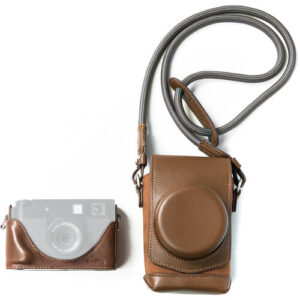-
 SmallRig Leather Camera Case for FUJIFILM X half (Brown)
×
₨3,2501 × ₨3,250
SmallRig Leather Camera Case for FUJIFILM X half (Brown)
×
₨3,2501 × ₨3,250
2.07MP 1/2.8″ CMOS Sensor
ToF Autofocus Technology
HDMI Output, USB 3.0 Interface
Up to 1080p at 60 fps Video
72.5° Wide-Angle Lens, 12x Optical Zoom
0.5 Minimum Illumination
RS-232 for Remote Control
RJ45 Ethernet Port
1 x 3.5mm Line Input
Power via USB or DC Input
The defaulted orientation for the Arocam C2 is portrait, which is perfect for livestreaming to social media platforms like TikTok and Instagram. You can switch back to traditional, horizontal framing by changing the settings internally.
With an advanced focusing algorithm and ToF module equipped, the lens can focus quickly and accurately. Infrared light gauges the depth and distance of objects in front of the lens before adjusting the camera’s settings. This high-tech feature is intuitive and automatic, so no need to worry if you’re out of focus during your presentation or Q&A.
The camera adopts a 4:2:2 10-bit color mode and has a 1/2.8″ CMOS sensor with 2.07MP for high-quality, full HD images and backlight compensation.
The sensor has ultra-high 55 dB SNR to effectively reduce image noise in low illumination. 2D and 3D noise reduction reduces noise, even in low-light conditions to keep the picture clean and clear.
The camera supports a wide rotation range of 340° horizontally and 120° vertically. Control over these parameters can be achieved via the RS-232 port with the included remote control. This allows you to frame your shot without needing to move the camera from is perch.
USB-C output plug-and-play makes for a convenient and simple user experience. Compatible with USB 3.0 and USB 2.0, the camera supports video and encoding image output as well as UVC V1.1 and UAC 1.0 protocols. The interface is compatible with Windows 7/8/10, MacOS X, Linux, and Android operating systems.
An HDMI output can deliver your video and audio to a display monitor.
An RS-232 port allows for remote control of the Arocam and a network-adaptive Ethernet port expands the camera’s interface even further for seamless livestreaming.
A 3.5mm audio input allows for microphone or line-level integration.
Power for the device can be achieved via the DC input or via the USB-C port.
| Type of Camera | Live Production |
|---|